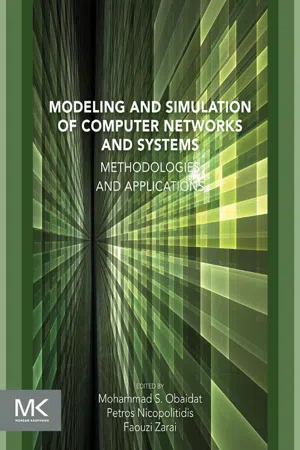
Modeling and Simulation of Computer Networks and Systems
Methodologies and Applications
- 964 pages
- English
- ePUB (mobile friendly)
- Available on iOS & Android
Modeling and Simulation of Computer Networks and Systems
Methodologies and Applications
About This Book
Modeling and Simulation of Computer Networks and Systems: Methodologies and Applications introduces you to a broad array of modeling and simulation issues related to computer networks and systems. It focuses on the theories, tools, applications and uses of modeling and simulation in order to effectively optimize networks. It describes methodologies for modeling and simulation of new generations of wireless and mobiles networks and cloud and grid computing systems.
Drawing upon years of practical experience and using numerous examples and illustrative applications recognized experts in both academia and industry, discuss:
- Important and emerging topics in computer networks and systems including but not limited to; modeling, simulation, analysis and security of wireless and mobiles networks especially as they relate to next generation wireless networks
- Methodologies, strategies and tools, and strategies needed to build computer networks and systems modeling and simulation from the bottom up
- Different network performance metrics including, mobility, congestion, quality of service, security and more...
Modeling and Simulation of Computer Networks and Systems is a must have resource for network architects, engineers and researchers who want to gain insight into optimizing network performance through the use of modeling and simulation.
- Discusses important and emerging topics in computer networks and Systems including but not limited to; modeling, simulation, analysis and security of wireless and mobiles networks especially as they relate to next generation wireless networks
- Provides the necessary methodologies, strategies and tools needed to build computer networks and systems modeling and simulation from the bottom up
- Includes comprehensive review and evaluation of simulation tools and methodologies and different network performance metrics including mobility, congestion, quality of service, security and more
Frequently asked questions
Information
Wireless and mobile technologies and protocols and their performance evaluation
Keywords
1 Introduction
2 Wireless and mobile technologies
2.1 2G and 2.5G technologies
2.1.1 GSM
Table of contents
- Cover image
- Title page
- Table of Contents
- Copyright
- List of contributors
- Preface
- Part 1: Protocols and services in computer networks and systems
- Part 2: Approaches in performance evaluation
- Part 3: Modeling approaches of computer networks and systems
- Part 4: Simulation methodologies in computer networks and systems
- Part 5: Next generation wireless networks evaluations
- Part 6: Modeling and simulation for system security
- Index